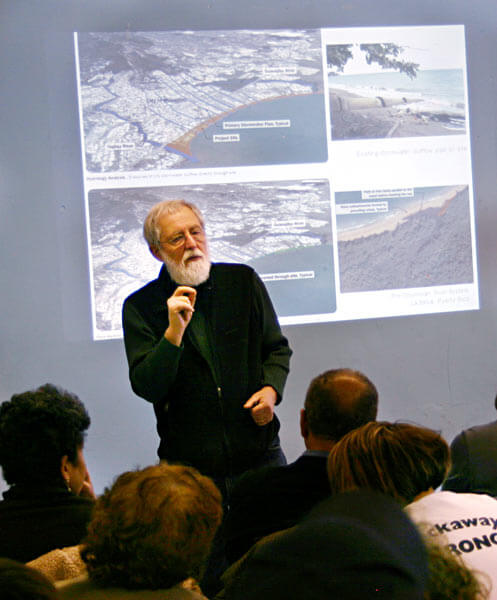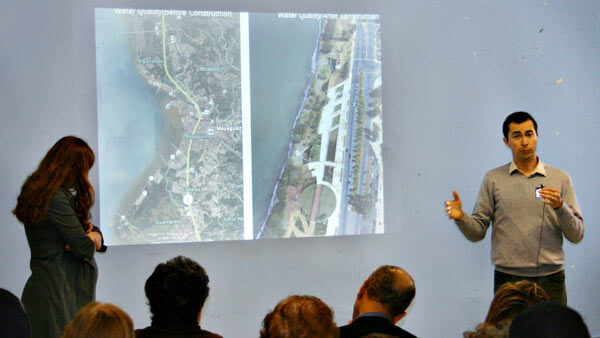By Rich Bockmann
Experts in the fields of urban planning, sustainable development and grassroots organizing met with community members in Arverne over the weekend to discuss how the Rockaways would plan for future floods.
Experts discussed ideas such as dunes, man-made reefs and sand banks — large dumps of sand positioned so the current redistributes the sand naturally, as opposed to constantly replenishing beaches. Sea walls were even briefly discussed, though a representative from the Netherlands consulate general said the technology has fallen out of favor in his country.
Arjan Mraamskamp said the Dutch had their superstorm in 1953, and it forced the country to rethink its approach to floodwaters.
“In the Netherlands the flood zone is two-thirds of the country,” he said, explaining that the low-lying nation shifted from dikes and seawalls to infrastructure that accepts flooding as an inevitability. “It’s not rocket science. Just keep the water where it can do the least amount of damage.”
About 100 people from up and down the peninsula packed into the community room at the Ocean Village apartment complex, where the Rockaway Waterfront Alliance holds its after-school program.
“People keep asking the questions, ‘Should we build a boardwalk? Should we put trees in?’” Executive Director Jeanne DuPont explained. “We thought this was a great way to bring some of the scientists and academics to the Rockaway community.”
Klaus Jacob, a professor of International and Public Affairs at Columbia University, said the threat of the ocean’s waters can no longer be ignored, as the likelihood of another 100-year flood is only going to get greater in the future.
“You throw the dice 100 times and out of 100 you get one winner,” he said. “By the end of the century you’re going to have to throw the dice only twice.”
The professor said that no matter what solutions planners choose, a comprehensive plan would have to be laid out.
“What’s really missing is in the city, state and in communities everywhere, we don’t know what our city will look like in the future,” he said.
Urban designer Walter Meyer said solutions range from the small — like burying old Christmas trees to create dunes — to the large, like having government adopt coastline replenishment as part of its regular budget as the Dutch do. He said no matter what the solutions, the key factor would be community involvement.
“This is one time where we can bring the east side of Rockaway and the west side of Rockaway to speak with one voice,” he said.
Meyer gave a nod to one resident whose seemingly small efforts helped saved a number of homes during the storm.
Richard George, of the Beachside Bungalow Preservation Association, received a grant in the 1990s to plant trees and grasses along the dune near Beach 58 Street. Meyer said that when Superstorm Sandy’s surge hit the dune, it split to both sides, saving dozens of bungalows.
“Back then nobody thought of those things,” George said.
Reach reporter Rich Bockmann by e-mail at rbockmann@cnglocal.com or by phone at 718-260-4574.


































